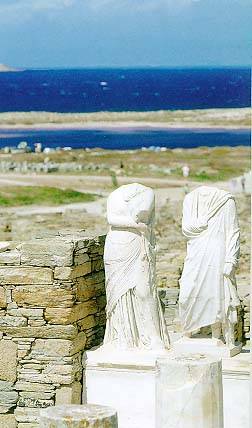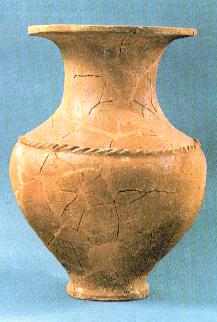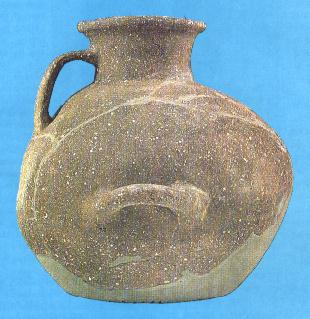|
The Cyclades Art
 Important
creations of the Cycladic civilization were the clay, stone
and bronze vessel utensils. And of course, above all, the very
famous marble statuettes, the so-called "little
idols". In the first stages all the vessels in general
were hand- made, without a potter's wheel.
Important
creations of the Cycladic civilization were the clay, stone
and bronze vessel utensils. And of course, above all, the very
famous marble statuettes, the so-called "little
idols". In the first stages all the vessels in general
were hand- made, without a potter's wheel.
The
vessels were of two kinds: the spherical and the cylindrical
forms of the pixies, which were used as Jewellery boxes. They
characterize the Clay civilization of Ñylïs -Lakkoudes
(Melos-Naxos). We find a more advanced form of the same
vessels in Keros (an uninhabited island, pasturing ground),
next to Amorgos and Syros during the second phase. The
characteristics of this period were the "fry-pan"
vessels. They were often made of clay, had the shape of a
frying pan and their use is still unknown today.
They
may possibly have been the first from of mirrors (C.Tsountas).
Their bottom exterior section was decorated with incisions and
impressed designs, often-concentric circles and bands, and
schematic representations of ships. The incisions were covered
in white clay. The civilization of Keros-Seers introduced to
Cycladic pottery the use of a primitive glaze and
contemporarily developed the art of colour and the potter's
wheel. The motifs were geometric and initially in a
white colour: later, they were in black on light-collared
surfaces. The technique of the vessels developed even more and
reached its peak in the third phase of the Cycladic
civilization, the so - called Phylakopi Polies (Melos). The
types of vessels developed while others appeared for the first
time. Here the conical one replaced the cylindrical pixie.
Vessels made for use, of great skill, were developed. They
were the "askos" (skin bag) (a clay table-ware
vessel for wine or water), the "kernos" (pouring
vessel) and a great variety of animal-shaped vessels that were
natural looking and had plastic value. The decoration was no
longer incised but inscribed.
 Apart
from the clay vessels, the marble ones are also important. The
abundance of marble in the Cyclades helped in this. Glasses,
"craters" (mixing bowls for wine), hemlocks, footed
"kylixes" (wine cups), zoomorphic vessels, fine
works of orotund other utensils were made of marble, as well
as of Grey schist and bright red stone. But the creations,
which characterize the Cycladic civilization and express more
strongly and are more representative of the civilization, are
the little marble idols. The abundance of the primary material
helped the craftsman to pursue both solutions and originality. Apart
from the clay vessels, the marble ones are also important. The
abundance of marble in the Cyclades helped in this. Glasses,
"craters" (mixing bowls for wine), hemlocks, footed
"kylixes" (wine cups), zoomorphic vessels, fine
works of orotund other utensils were made of marble, as well
as of Grey schist and bright red stone. But the creations,
which characterize the Cycladic civilization and express more
strongly and are more representative of the civilization, are
the little marble idols. The abundance of the primary material
helped the craftsman to pursue both solutions and originality.
Almost no other prehistoric civilization reached the analogies
in plastic work that we meet in the Cycladic idols. Their
production lasted all of the third millennium without
interruption. In the beginning, because there were no metals,
the tools were primitive and the statuettes were simple and
completely schematic. They looked like squashed pebbles. They
were the first attempts of the craftsman to impose himself to
the rough material and to give it shape and soul. The metal
tools gave him great opportunities. He overcame the lifeless
material and imprinted in an impressive way his ideas and
emotions. The idols now took the shape of violins, they
imprinted the human body and from schematic they became
more natural - looking (naturalistic). They were full- bodied
female figures with almond shaped head, sculptured eyes, mouth
and ears. The breasts were modelled, the hands were not joined
together and the soles of the feet were in a horizontal
position.
The second phase introduced a new type of idol. The
head now took a new shape that of a lyre slightly tilted back.
The hands were crossed under the breasts with the
left forearm above the right one. The knees were slightly bent
and the foot soles sloping, giving the impression that the
figure was raised on its toes. The eyes and mouth were
indistinguishable, as were the fingers of the hands. Many of
them portrayed women in the late stages of pregnancy. This
type, with small local variations, was the most common type of
Cycladic idol. The Cycladic idols were characterized by a
strict frontally. They were like two - dimensional painted
works and intended
to be seen only frontally, not sideways.
Of course, the
Keros-Syros civilization produced figures that show the
artist's attempt to free him self from substance. This
capacity of a third dimension was clearly brought out in the
magnificent Harper of Keros and the Piper. The idols of the
musicians, as well as the "Propinon" (literally
"the one making a toast") (has his right hand raised
for a toast) are also as wonderful. The Hunter and others
represent male figures. What the idols were is still a dark
and unsolved subject. Their dimensions, from 0.50 m to 1.50 m,
complicate the problem even more. Perhaps they represent
divinities, or nymphs and heroes, children's toys or charms.
Neither does the fact that they were found in tombs answer the
question because many existed before the tombs. Then again,
they may have been items of everyday use. At any rate, their
aesthetic value, their skill, there plasticity are all very
high and they are considered the distant ancestors of modern
sculpture.
 Even
though they are of a lesser value than the idols, the
decorative items of the Cycladic art are also considered
important. There are necklaces decorated by stone beads or
seashells. Silver pins, diadems, shaving blades and obsidian
works. Én the museum of Apiranthos in Naxos there is a series
of carved stones representing scenes of everyday life of that
period, something that shows that the art of the rocks was
flourishing. Most of the finds of Cycladic art are found at
the National Archaeological Museum in Athens and many are also
found in the Goulandri Collection. Even
though they are of a lesser value than the idols, the
decorative items of the Cycladic art are also considered
important. There are necklaces decorated by stone beads or
seashells. Silver pins, diadems, shaving blades and obsidian
works. Én the museum of Apiranthos in Naxos there is a series
of carved stones representing scenes of everyday life of that
period, something that shows that the art of the rocks was
flourishing. Most of the finds of Cycladic art are found at
the National Archaeological Museum in Athens and many are also
found in the Goulandri Collection.
After
2000 BC the Cycladic civilization lost, to a degree, its
particularity. The Cycladians were influenced by the Minoan
civilization; a new civilization, a combination of these two,
was created. This can be seen in the houses, which have wall
paintings of Minoan influence. Also, the tombs of small
children were different from those of the Protocycladic
civilization. In the art sector the role of the Cyclades was
limited to pottery. The vessels of this period, which is
called the Mesocãcladic (Middle Cycladic civilization and
extends from around 2000 to 1500 BC, was an encounter and a
combination of three civilizations: the Cretan the Cycladic
and the Mainland Greece one.
Following the destruction of the
Minoan civilization by the volcano of Thera at around - 1450
BC, the Cycladic islands came under the influence of the
Mycenaean civilization, up to the end of the Bronze Age at
around 1100 BC. From that point on their civilization followed
the more general characteristics of every big phase that
followed and in a way lost its autonomy. In the years that
followed, from 1100 to 800 BC, the Cyclades were inhabited by
colonists, mainly Ionians except for Melos which was inhabited
by the Doreans and Kithnos, inhabited by the Driopes. At the
peak of the Archaic period in the Cyclades, as in mainland
Greece, pottery was the art that flourished. Under the
influence of the Attic style, the Cycladic workshops (of
Naxos, Paros, Melos, Thera) produced important creations and
emphasized their presence in the art of pottery of the period.
During the period from 700 to 550 BC Naxos, with its marble
quarries and its skilled craftsmen, Flourished. Works, famous
all) over Greece, were produced among them were the famous
lions of Delos (7th BC century).
Siphnos became renowned for
its gold and silver, as well) as for its "thesaurus"
("treasure") -as it was called which was constructed
by the Siphnians at Delphi. In the middle of the 7th century
there was a flourish in plastic art to which the Cycladic
contribution was important. Á splendid example of this is the
votive offering of Nikandra in Delos, in honour of the
goddess Artemis (Diana), one of the first examples of the
great Athenian plastic art. One hundred years later the famous
Kouros of Melos, with his "archaic smile", was
created.
 During
the Classical period Melos once again gave to eternity the
goddess Aphrodite (Venus), a work of exquisite beauty and
workmanship. The era of Alexander the Great and the
Hellenistic period transferred the centre of the world from
Athens and this affected the Cyclades as well as other places.
Á notable creation of this period is the portico of Antigonos
Gonatas in Delos, the most renowned portico of the Hellenistic
period. During
the Classical period Melos once again gave to eternity the
goddess Aphrodite (Venus), a work of exquisite beauty and
workmanship. The era of Alexander the Great and the
Hellenistic period transferred the centre of the world from
Athens and this affected the Cyclades as well as other places.
Á notable creation of this period is the portico of Antigonos
Gonatas in Delos, the most renowned portico of the Hellenistic
period.
Another important work of the late Hellenistic period
was the Ìïsaic of Delos with Dionysus riding the panther.
Delos flourished during this period, after the subjugation of
Greece by the Romans and in spite of the immense
"stripping" of the cities and the temples the
artistic production of the Greek cities did not stop. The
Cycladites moved to the same rhythm. The royal portico of
Thera at the time of Augustus was important.
During
the Byzantine era art was expressed mainly through painting
and the architecture of churches. Among the basilicas (a
rhythm of churches) of the Byzantine Empire the Katapoliani of
Paros (or Ekatopyliani of Paros or Ekatontapyliani) stands out
as the most significant monument of the period of Justinian.
In the later Byzantine years (the years of the " black
chasm " during the 7th century), the Virgin Mary of
Drosiani in Naxos is the work that is most notable, with its
remarkable wall paintings. Later, during the 8th and 9th
centuries, Saint Artemios and Saint Kyriaki, with their
non-figural wall paintings, represent the iconoclastic art in
churches, as does the vaulted basilica of Saint Ioannis the
Theologue at Apirathos of Naxos.
The iconoclastic church at
Chalki of Naxos presents notable wall paintings with crosses
under the arch line. One famous church of the 10th
century AD is the double - clowned church of Taxiarchos of
Melida in Andros. A Cycladite sample of votive painting of the
12th century AD is the wall paintings at the Diocese
("Episkope") of Santorini. During the years between
1300 and 1350, we meet the so-called Palaeologan art on the
small island Anafi. During the periods of Turkish and Venetian
rule, the art in the Cyclades followed the fate of the Greek
nation. What is characteristic of the period of the Venetian
rule is the literally great number of churches that were
built, as well as their varieties. Indeed when Crete fell to
the Turks in 1669 the great Cretan painters fled to the
Cyclades where they continued their significant work.
From the
early 17th century we meet the painters of the
"Diaspora" (literally: "the dispersed
ones") such as Emmanuel Skordilis , the monk lakovo
(cob), Michelis Kritikos (in Amorgos) and Makarios Kalliergis.
They themselves and their paintings both deeply influenced the
native craftsmen; painting was gradually transformed to á
more "folklore" art which would later portray the
soul of the Cycladites, in á vast number of
"folk-lore" icons and their expression and hope to
the hardships of slavery would rest there for the two
following centuries.
|
>> Cyclades Islands : Amorgos, Anafi,
Andros, Antiparos,
Delos, Folegandros,
Ios, Kea,
Kimolos, Kithnos,
Koufonisia, Milos,
Mykonos, Naxos,
Paros, Santorini,
Serifos, Sifnos,
Sikinos, Syros,
Tinos.
|
|